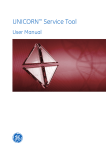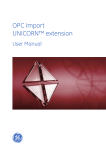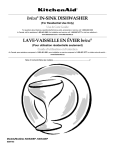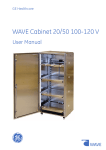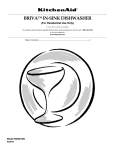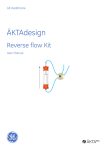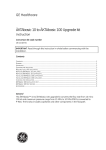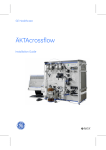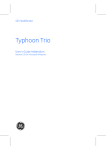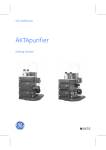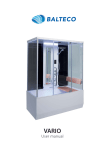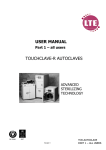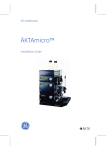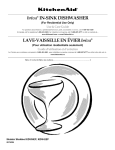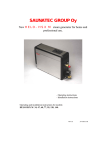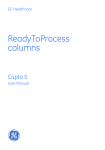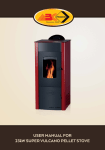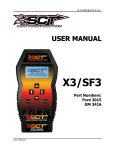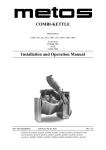Download GE_UM_NFF SIP_E - GE Healthcare Life Sciences
Transcript
GE Healthcare NFF Steam In Place 28-9137-77 AA Table of contents Introduction 3 General principles 4 Steam quality The temperature pressure relationship Differential pressure Filter housing installation Condensate removal Steam traps Integrity testing Cartridge filter steam life 4 4 4 5 5 5 5 6 Practical SIP 6 Steam-in-Place procedures 7 Forward Steam-in-Place procedure liquid filter applications Forward Steam-in-Place procedure air filter applications Reverse Steam-in-Place procedure air filter applications 2 User Manual 7 8 9 Introduction The ability of a cartridge filter to be sterilized in situ within its housing represents a significant operational advantage for many filter users. Steam in place (SIP) avoids the need to use chemical sanitizing agents or to compromise the integrity of the filtration installation, minimizes operator hands-on time and plant downtime and can be easily incorporated into automated production facilities. To achieve reproducible sterilization conditions (typically a minimum of 121°C for 30 minutes) and to avoid damage to the installed filter cartridge(s), it is important to carefully design and monitor SIP procedures. Factors including steam temperature and quality, condensate removal, differential pressure and cooling cycles need to be considered. The purpose of this document is to detail the recommended methods of SIP for GE Healthcare cartridge filters, to avoid accidental damage to cartridges and maximize the steam life of installed filters. Validation and product certification To certify that GE Healthcare products meet the required regulatory and quality standards of the industries we supply, all filters are supplied with a certificate of quality. These certificates are linked to validation guides for both pre-filter and sterilizing grade membrane filter cartridges that define methodologies and data appropriate to each filter type. This information typically includes: • technical specifications • biological safety testing including Current USP<88> Class VI 121°C Plastics • extractable testing including 21 CFR 211.72 and 210.3(b), (6) for fiber releasing filters • effluent quality including TOC, bacterial endotoxins, water conductivity and particle release • chemical compatibility information GE Healthcare - Setting the standard GE Healthcare brings extensive experience through our scientists, engineers and sales representatives to the process of offering specific filtration systems to meet the needs of your production process. Support services are available covering a wide range of activities including scale up advice from laboratory through pilot scale to production systems, validation support, design and manufacturing of custom housings and filtration products and on-site technical support. • thermal stability • correlation of a non-destructive integrity test to a defined bacterial challenge Validation support services GE Healthcare has extensive laboratory facilities and trained personnel capable of providing a range of validation support services to support manufacturers in meeting their requirements for process validation relating to the use of filtration products. Committed to quality Quality is of paramount importance to GE Healthcare. As such GE Healthcare is certified to ISO 9001, providing a quality management system that covers the entire organization from R&D, production, warehousing, materials management and customer support. In addition, our manufacturing facilities operate to the principles of cGMP. User Manual 3 General principles Steam Quality Condensate Optimum steam sterilization of filter cartridges can be achieved using dry steam. Wet steam (steam containing a high level of condensed water) will not flow easily through the filter. This resistance to flow will generate increased differential pressure across the filter at elevated temperatures, conditions which cause the maximum stress to the filter cartridge. Condensate should therefore be removed by a manual valve or an automated steam trap, located as close to the filter as possible, to avoid condensate contact with the filter. Particulates Many steam lines suffer from corrosion over a prolonged time period. This can introduce particulates into the steam which will be retained by the filter being steamed. This will accelerate the rate of filter blockage or worse, cause damage to the filter. Pipe corrosion can result in metal fragments which when carried to the filter could puncture the support materials and membrane. Chemical Activities Chemicals are often added to the feed water in steam generators. These chemicals will form part of the steam and so will contact the filter cartridge being steam sterilized. Most standard steamgenerator additives do not pose any problem for the steam filter or filter cartridge being sterilized. If you have any doubt regarding steam generator additives please contact Technical Support. The temperature pressure relationship There is a direct relationship between steam temperature and pressure. Increasing the steam pressure facilitates an increase in the temperature of the pressurized steam. The following graph illustrates this relationship. As saturated steam is pressurized its temperature increases. To assure sterility, it is typically recommended that a temperature of 121°C be maintained over at least 30 minutes. A pressure of 1.1 barg is required to achieve this temperature (actually equates to 121.8°C). However, 1.0 barg equates to 120.2°C and so would not be sufficient to give a high degree of assurance that sterility has been achieved. It is therefore important that appropriate devices are installed to directly record either steam temperature or the pressure. Differential pressure Filters should generally be supplied with steam from the upstream side (normal flow direction). Steam flow from the downstream side should be avoided. Reverse flow should not be used for liquid filters. Steam should not be applied to both sides of the filter at the same time as this can potentially trap a pocket of dry air between the steam supplies, reducing the heat transfer to the filter and therefore negatively impacting the steam sterilization conditions. During normal steam sterilization cycles, as steam is applied to the filter housing, air is purged from the system such that saturated steam contacts and heats all the filter and housing surfaces. As the steam heats and subsequently flows through the cartridge filter, there will be an inherent resistance to that flow. The amount of resistance to the steam flow is measured as a drop in pressure across the filter and is called the differential pressure. Differential Pressure = Upstream Steam Pressure - Downstream Steam Pressure Steam pressure can be expressed in two forms: 1. Absolute pressure, which includes atmospheric pressure. Therefore sterilization would require 2.1 bar (absolute). 2. Gauge pressure is the pressure above atmospheric pressure. Therefore sterilization would require 1.1 bar (gauge). Temperature Pressure Relationship The differential pressure can be influenced by many factors including the micron rating of the cartridge filter, the degree of blockage due to retained contamination, the influence of condensate and the rate of steam flow through the cartridge filter. While filter cartridges can withstand high differential pressures (up to 5 barg) at ambient temperature, it is important to limit differential pressure at elevated temperature. 135 Temperature (°C) 130 125 120 115 110 105 100 0 0.2 0.4 0.6 0.8 1.0 1.2 1.4 1.6 1.8 Pressure bar (Gauge) Thermodynamic and Transport Properties of Fluids. SI units by G.F.C Rogers and Y.R Mayhew. Oxford Basil Blackwell 1981 (0631 128913). 4 User Manual 2.0 When a cartridge filter is heated to 121°C or higher, this procedure places significant stress on the unit. During the SIP process the physical properties of the cartridge filter components are weakened at elevated temperature (e.g. increased plasticity of polymers). It is therefore important that at temperatures of 121°C or higher, the differential pressure across the filter cartridge not exceed 0.3 barg. Differential pressure above this level may lead to filter damage. Consideration of process parameters to limit differential pressure during SIP is therefore critical and includes: 1. Ensuring efficient condensate removal during the entire SIP cycle. 2. Minimizing steam flow rates through the cartridge filter. 3. Minimizing the downstream pipework steamed through the filter cartridge. 4. Control and measurement of the temperature and differential pressure during filter cartridge SIP. 5. Removal, post SIP, of as much of the steam as is practical to reduce condensate formation in the cartridge filter. This is particularly relevant for hydrophobic gas filter cartridges. 6. Controlled cooling of filter cartridges post SIP, to ensure hydrophobic filter cartridges are not blinded by condensate. 7. Controlled cooling of filter cartridges post SIP to prevent potential thermal shock by crash cooling or cold product introduction. Filter housing installation The following considerations should be given to the installation of filter housings that will be steam sterilized: • The installation should ensure that condensate cannot accumulate in the housing. Housings or upstream pipework should therefore be fitted with condensate drains. Condensate removal is particularly important when steam sterilizing hydrophobic gas filter cartridges. • The cartridge and housing should be in a normal orientation (vertical, with the open end of the cartridge pointing downwards). • The pipework downstream of the filter housing should be as short as possible. GE Healthcare recommends a maximum of 100cm. Tanks downstream of the filter should always be steam sterilized separately. • Pressure gauges capable of accurate reading over the minimum range of 0-3bar at the SIP temperature should be installed upstream and downstream of the filter housing, to allow differential pressure measurement. • The pipework should be positioned at a slight incline allowing gravity to collect the steam condensate at a steam drain or steam trap. • Length of pipeline, relative to steam flow rate, may result in pressure loss. The length of steam supply pipework should be kept to a minimum. Condensate removal While saturated steam behaves as a gas and so flows easily through filters, contact with any cool surface (e.g. stainless steel housings or pipework) will lead to the generation of condensate as the steam cools. In some systems, very large volumes of condensate may be generated due to this process (e.g. multiple cartridge housings, extended pipework etc). In any case, the removal of condensate from any SIP system is important for a number of reasons: 1. Condensate can ‘blind’ both hydrophilic and hydrophobic membranes to steam flow, potentially leading to filter damage due to the development of high differential pressures across the membrane at high temperature. 2. Condensate will be at a temperature below the required steam sterilization temperature. It is therefore important to remove condensate to ensure effective steam sterilization. 3. Hydraulic shock may occur due to ‘slugs’ of steam being forced through the line. In designing process systems, the effects of condensate generation can also be minimized by ensuring that housings are not located at the bottom of long pipe runs, or that these are steam sterilized separately from the filter. Steam traps As discussed above, the removal of condensate from systems is important to ensure efficient steam sterilization. A thermodynamic steam trap or condensate trap is a mechanical valve to remove condensate. They are located at points upstream and downstream of the filter where condensate would collect (i.e. low points in the system). These steam traps work on the principle that as condensate collects the temperature at the trap falls below that required for effective steam sterilization (121°C). At this point the valve opens, drains the condensate and draws in live steam from the steam supply. Steam traps can be replaced by a manual valve that is left slightly open, but requires control by a skilled operator to ensure effective condensate removal without draining excessive steam. Integrity testing Steam sterilization under carefully controlled conditions is an accepted process operation for filter cartridges. However, this does represent an aggressive process condition and can lead to filter damage should steam sterilization conditions deviate from controlled norms. It is therefore recommended that filter cartridges are integrity-tested in-situ after steam sterilization and before use. For advice on in-situ integrity testing of filter cartridges please refer to GE Healthcare Technical Support. User Manual 5 Cartridge filter steam life Recommended maximum steam life for GE Healthcare filter cartridges at a range of temperatures is shown in Table 1. It should be noted that these are provided as guidelines as actual filter life will depend on individual steam sterilization conditions. Filter type SIP temperature (ºC) Single cycle exposure time (mins) Maximum number of cycles ULTA PURE SG 130 30 30 ULTA PURE HC 130 30 30 ULTA PRIME CG 130 30 30 ULTA PRIME PP 135 30 30 ULTA PRIME GF 121 30 10 Practical SIP The following sections in this guide provide step by step procedures for developing SIP protocols in three operational conditions: 1. Liquid filters steamed in the forward direction. The steam flows in the same direction as the liquid product (from outside to inside of the filter cartridge). The filter has a membrane that is hydrophilic. 2. Gas filters steamed in the forward direction. The steam flows in the same direction as the gas product (from outside to inside of the filter cartridge). The filter has a membrane that is hydrophobic. 3. Gas filters steamed in the reverse direction. The steam flows in the opposite direction (inside to outside of the filter cartridge) to the designed direction of flow for the gas product. The filter has a membrane that is hydrophobic. Each procedure has a system diagram and valve sequence table to illustrate the step by step procedure. The procedures represent ideal systems for SIP, which may not be identical to existing systems. For recommendations, modifications or more information regarding these procedures please contact the GE Healthcare Technical Support Group. 6 User Manual Forward Steam-in-Place procedure liquid filter applications 1. Set the valves to positions indicated for pre Steam-In-Place. 2. Drain the product from the filter system and associated pipework. Opening valve V5 will aid this process. 3. Open valve V1 and allow the steam condensate to drain until the steam trap below valve V3 closes. Close valve V9. 4. Slowly open V3 allowing steam into the system: this will flow across the filters and through valve V4 & V5. This will allow the heating of the housing, the filters and associated pipework without generating a significant differential pressure across the filters. Note: The steam trap below valve V3 & V4 will receive the condensate and will repeatedly open and close. 5. When ‘live’ steam flows from valve V5, close valve V5. This will direct the steam through the heated filter, close valve V10. 6. Observe the pressure gauges P1 and P2 and control the steam flow rate at valve V3 to ensure the differential pressure does not exceed 0.2 - 0.3 barg. 7. When the steam trap below valve V6 closes, the steam pressure will begin to rise. 8. Ensure the steam pressure/temperature does not exceed the maximum allowable pressure/temperature for the cartridge type being steamed. If reading from pressure gauges it is recommended the maximum steam pressure is 2.0 barg in the forward direction. 9. Steam sterilize the cartridges for 30 minutes ensuring the conditions stated in steps 5 to 7 are followed. The valves should now be in positions indicated for Steam-In-Place. 10. On completion of the Steam-In-Place cycle, close V4, V6, V3 and V1 in that order. 11. Slowly open V10 to release the steam pressure from the filter system and associated pipework. When the pressure on P2 reads 0.1 barg pressure close valve V10. Fully open valve V9 to release the remaining steam pressure from the filter system. When the pressure on P1 reads 0.1 barg pressure, close valve V9. 12. Allow the system to cool for 30 minutes. The valves should now be in the positions indicated for post Steam-In-Place. NOTES: 1. A double downstream valve (V7, V8) is recommended so that under the cartridge steaming protocol the valves sealing faces of V7 can be effectively sterilized. The sealing valve faces of V8 can be similarly sterilized when the tank is steamed. When steam sterilizing the tank, V7 would be closed and V6 and V8 open. Normally the tank would be steamed separately before steaming the filter. If the filter is steamed before steaming the tank it is recommended that valve V7 is closed in the post Steam-In-Place settings to maintain sterility. The valve V7 must be closed during Step 10. 2. Valve V7 should be installed horizontally and valve V6 / steam trap installed immediately downstream of V7. 3. All drains should be fitted vertically to allow liquid removal. 4. Large volume downstream systems should not be steamed through the filter; e.g. when steaming process tanks a secondary steam supply should be used. User Manual 7 Forward Steam-in-Place procedure air filter applications 1. Set the valves to positions indicated for pre Steam-In-Place. 2. Open valve V1 and allow the steam condensate to drain until the steam trap below valve V3 closes. 3. Slowly open V3 allowing steam into the system: this will flow across the filters and through valve V4 & V5. This will allow the heating of the housing, the filters and associated pipework without generating a significant differential pressure across the filters. Note: The steam trap below valve V3 & V4 will receive the condensate and will repeatedly open and close. 7. Ensure the steam pressure/temperature does not exceed the maximum allowable pressure/temperature for the cartridge type being steamed. If reading from pressure gauges it is recommended the maximum steam pressure is 3.0 barg in the forward direction. 8. Steam sterilize the cartridges for 30 minutes ensuring the conditions stated in steps 5 to 7 are followed. The valves should now be in positions indicated for Steam-In-Place. 9. On completion of the Steam-In-Place cycle, close V4, V6, V3 and V1 in that order. 10. Fully open V5 to flash-dry the filter (or 10a). 4. When ‘live’ steam flows from valve V5, close valve V5. This will direct the steam through the heated filter. 10a. Open V2 to allow compressed air into the system. The pressure of the air should be no more than 0.5 barg above the steam pressure. 5. Observe the pressure gauges P1 and P2 and control the steam flow rate at valve V3 to ensure the differential pressure does not exceed 0.2 - 0.3 barg. 11. Allow the system to cool for 15 minutes, then close V5 (flashdry only). The valves should now be in the positions indicated for post Steam-In-Place. 6. When the steam trap below valve V6 closes, the steam pressure will begin to rise. NOTES: 1. A double downstream valve (V7, V8) is recommended so that under the cartridge steaming protocol the valves sealing faces of V7 can be effectively sterilized. The sealing valve faces of V8 can be similarly sterilized when the tank is steamed. When steam sterilizing the tank, V7 would be closed and V6 and V8 open. Normally the tank would be steamed separately before steaming the filter. If the filter is steamed before steaming the tank it is recommended that valve V7 is closed in the post Steam-In-Place prior to maintain sterility (step 9). 2. Valve V7 should be installed horizontally and valve V6 / steam trap installed immediately downstream of V7. 3. All drains should be fitted vertically to allow liquid removal. 4. Large volume downstream systems should not be steamed through the filter; e.g. when steaming process tanks a secondary steam supply should be used. 5. Installation/use of GE Healthcare air filter housings which utilize a plenum chamber are recommended, as this facilitates the collection and drainage of condensate. 6. When steaming in the reverse direction please contact GE Healthcare Technical Support for guidance. 8 User Manual Reverse Steam-in-Place procedure air filter applications 1. Set the valves to positions indicated for pre Steam-In-Place. 2. Open valve V1 and allow the steam condensate to drain until the steam trap below valve V2 closes. being steamed. Continue to monitor the P using gauges P1 and P2. If the differential pressure exceeds 100 mbar stop the sterilization procedure and rectify the cause of the pressure drop before proceeding with the sterilization routine. 7. Steam sterilize the cartridges for 30 minutes. The valves should now be in the positions indicated for Steam-In-Place. (This method is typically suited to single cartridge systems). 3 Slowly open V2 allowing steam into the system. 4. Observe the pressure gauges P1 and P2 and control the steam flow rate at valve V2 to ensure the P across the filter does not exceed 0.1 barg. If the P exceeds 100 mbar stop the sterilization procedure and rectify the cause of the pressure drop before proceeding with the sterilization routine. 5. When line steam flows from valve V6, close valve V6. When the steam trap below valve V5 closes, the steam pressure will begin to rise. 8. On completion of the steam cycle time, close V5, V2, V1 in that order and then rapidly open V6 to flash dry the filter (or 8a). 8a. Isolate steam supply and open V7 to allow air into the system. The pressure of the air should be no more than 0.5 barg above the steam pressure. 9. Allow the system to cool for 15 minutes then close V6, the valves should now be in positions indicated for post Steam-InPlace. 6. Ensure steam pressure/temperature does not exceed the maximum allowable pressure/temperature for the cartridge type NOTES: 1. A double downstream valve (V4, V3) is recommended so that under the cartridge steaming protocol the valve sealing faces of V4 can be effectively sterilized - the sealing valve faces of V3 can be similarly sterilized when the tank is steamed. When steam sterilizing the tank V4 should be closed and valve V3 open. To ensure adequate drainage at V3, there should be a slight fall in the pipework between V3 and the tank. As the same steam supply is used to sterilize the tank as well as the filter. A steam filter of a suitable flow rate capacity must be selected. 2. All drains should be fitted vertically to allow liquid removal. 3. There should be a ‘fall’ in the pipework from V3 so that liquid can drain into the tank. 4. Large volume downstream systems should not be steamed through the filter; e.g. when steaming process tanks a secondary steam supply should be used. 5. Installation/use of GE Healthcare air filter housings which utilize a plenum chamber are recommended, as this facilitates the collection and drainage of condensate. 6. Valve V7 should be placed as close as possible to the filter housing. If long lengths of pipe are present, the initial steam flows will be high as the downstream volume is pressurized. This high steam flow can change the cartridge. User Manual 9 www.gelifesciences.com/filtration GE, imagination at work and GE monogram are trademarks of General Electric Company. GE Healthcare Bio-Sciences AB Björkgatan 30, 751 84 Uppsala, Sweden All goods and services are sold subject to the terms and conditions of sale of the company within GE Healthcare which supplies them. A copy of these terms and conditions is available on request. Contact your local GE Healthcare representative for the most current information. © 2007 General Electric Company - All rights reserved. GE Healthcare Bio-Sciences AB, a General Electric Company. GE Healthcare Europe GmbH Munzinger Strasse 5, D-79111 Freiburg, Germany GE Healthcare UK Ltd Amersham Place, Little Chalfont, Buckinghamshire, HP7 9NA, UK GE Healthcare Bio-Sciences Corp 800 Centennial Avenue, P.O. Box 1327 Piscataway, NJ 08855-1327, USA GE Healthcare Bio-Sciences KK Sanken Bldg. 3-25-1, Hyakunincho, Shinjuku-ku, Tokyo 169-0073, Japan Asia Pacific Tel +65 6275 1830 Fax +65 6275 1829 Australasia Tel + 61 2 9899 0999 Fax +61 2 9899 7511 Austria Tel 01/57606-1619 Fax 01/57606-1627 Belgium Tel 0800 73 888 Fax 02 416 82 06 Canada Tel 800 463 5800 Fax 800 567 1008 Central, East, & South East Europe Tel +43 1 972720 Fax +43 1 97272 2750 Denmark Tel 45 16 2400 Fax 45 16 2424 Finland & Baltics Tel +358 (0)9 512 39 40 Fax +358 (0)9 512 39 439 France Tel 01 69 35 67 00 Fax 01 69 41 96 77 Germany Tel 089 96281 660 Fax 089 96281 620 Greater China Tel +852 2100 6300 Fax +852 2100 6338 Italy Tel 02 27322 1 Fax 02 27302 212 Japan Tel +81 3 5331 9336 Fax +81 3 5331 9370 Latin America Tel +55 11 3933 7300 Fax +55 11 3933 7304 Middle East & Africa Tel +30 210 9600 687 Fax +30 210 9600 693 Netherlands Tel 0800 82 82 82 1 Fax 0800 82 82 82 4 Norway Tel 815 65 555 Fax 815 65 666 Portugal Tel 21 417 7035 Fax 21 417 3184 Russia & other C.I.S. & N.I.S Tel +7 (495) 956 5177 Fax +7 (495) 956 5176 Spain Tel 93 594 49 50 Fax 93 594 49 55 Sweden Tel 018 612 1900 Fax 018 612 1910 Switzerland Tel 0848 8028 12 Fax 0848 8028 13 UK Tel 0800 616928 Fax 0800 616927 USA Tel 800 526 3593 Fax 877 295 8102 28-9137-77 AA 04/2007










